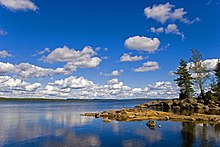Glava glass bridge
Glava Glasbruk was a glassworks in Sweden . It was located on Lake Stora Gla near Arvika in Värmland , was in operation from 1857 to 1939 and was the largest Swedish glassworks for window glass at the turn of the 20th century.
history
There were industrial settlements on Stora Gla as early as the 1800s. The Lenungshammar used a drop height of 19 meters in the rapids there between Övre and Stora Gla. The large forest area of Halvardsnäs was acquired in 1857 by the brothers Anders and Petter Olsson and Johan Kjellman in order to build a glass factory at Stora Gla. The forests around the lake formed the energy reserve for the glass furnaces.
On August 1st, 1856, glass was produced for the first time in Glava Glasbruk . The craft business began its production of hand-blown window glass with 42 employees. Soon a flour mill and a brick factory settled in the industrial plant. In September 1872 the glassworks burned down. With a new kiln , which was heated with gas instead of wood , production started again, with the company specializing entirely in the manufacture of window glass. Soda was delivered from England , limestone came from Gotland and the necessary sand was obtained from the nearby lake. These materials were delivered by water via Vänern , Byälven and Glafsfjorden .
In 1873 the craft business became a joint stock company , Glava Glasbruket AB . The company renovated the structure of the glassworks and the sawmill. A new gas generator was purchased for this purpose. In the autumn of 1876, the largest window panes were made of 1.65 × 0.54 meters. At that time, the factory was considered the most modern glass production facility in Sweden.
Between 1878 and 1879, production was completely changed despite the recession . A new melting furnace from our own construction produced good results. In 1885, the Glava Glasbruks järnvägsbygge department built the Glava Glasbruk – Glava railway from the grain mill to the port of Bergsviken on the Glafsfjorden. This meant a great simplification of the transport route, as the difference in altitude between Glafsfjorden and Stora Gla was 96 meters over a nine-kilometer route. This made it possible to dispense with horse-drawn carts. This railway existed until 1938.
In the 1890s, a melting tank was built in which 350 tons of glass mass could be kept liquid. Statistical data from 1899 provide information about the company: Under managing director Emil Larsson, the net profit amounted to 51,000 crowns , and 3258 tons of raw materials such as sand, lime and sulfate were consumed. From this, 225 employees produced 2503 tons of glass worth 575,000 crowns.
In 1911 the glassworks was destroyed again by fire. This fire was followed by the construction of an even larger new building complex made of brick with slate roofs . A new gas works with five generators was built for this purpose. 1.5 million m 2 of glass were now produced annually in three shifts with 80 workers each, which meant 38 percent of the Swedish production of window glass.
The company went through another recession in 1921. It could only be saved from bankruptcy when it was taken over by Svenska Fönsterglaskoncernen . From 1927 onwards, with the acquisition of a new glass drawing machine, it switched to mechanical glass drawing .
A protracted labor dispute began on March 28, 1939. This lasted so long that the further operation of the glassworks was no longer profitable. The sawmill and the Olsfors mill were also not in operation at the time. Therefore, like many other former mills in western Värmland, the entire industrial site including the associated forests was sold to Billerud AB - a paper manufacturer that still exists today.
A museum about the history of the glassworks is housed in the buildings, some of which still exist today .
Web links
- Föreningen Bruksgårdens hemsida. Retrieved February 1, 2016 (Swedish).
- History of the glassworks (swed.)
- Location of the glassworks and the railway
- Plan by Glava Glasbruk
Coordinates: 59 ° 31 '50.4 " N , 12 ° 28' 39.3" E
